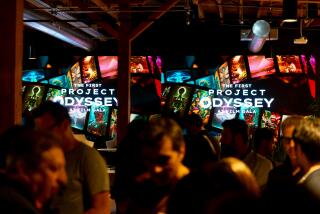In touch with five very moving works of art
- Share via
VISIT the fifth anniversary exhibit of UC Irvine’s Beall Center, and you could find yourself behaving a little strangely. The five pieces of interactive art in “5” are so playful and engaging, you might just dance to a painting. Or talk with inanimate objects. Or engage in a telekinetic battle with strangers.
“It’s what happens when you start interacting with a machine as though it’s a person,” said Pamela Winfrey, curator of “5,” as well as the Exploratorium museum of science, art and human perception in San Francisco. “Stand back and watch people, and there are lovely little vignettes of interaction going on.”
During a recent visit to the center, a trio of women spun around in front of Camille Utterback’s “Untitled 6,” a digital, abstract-expressionist artwork that changed shapes and color based on their movements. A few steps away, two other visitors strapped on bio-sensory headbands to play “Brainball,” a game developed by a Swedish art collaborative that uses the brain’s alpha and theta waves to control the action of a ball. In a counterintuitive spin on game play, the most relaxed player wins.
“Fun, family-friendly and celebratory were the criteria we were looking for,” Beall Center director Eleanore Stewart said.
The exhibition’s primary purpose is to celebrate the interdisciplinary arts center that, for five years, has been putting together “artists, computer scientists and engineers to create new forms of expression and new forms of experience for audiences in the arts,” she said. But it is also linked with UC Irvine’s soon-to-reopen arts plaza, designed by Vietnam Veterans Memorial artist Maya Lin.
Both highlight international connectedness and “the role of technology in expanding the human senses and our definition of the artistic experience,” Stewart said.
In the case of the outdoor arts plaza, which officially opens Tuesday, the intersection of the senses and technology manifests in multicolored runway lighting, trees strung with microphones, “whispering” benches, edible landscaping and an outdoor projection area. Webcams and LCD screens can show activities as they unfold in the plaza, as well as art from all over the world.
As for “5,” it means five artists from five countries, and a variety of multisensory experiences that play with the social implications and technological possibilities of sight, touch, hearing and smell.
“Most people in interactive art must think about the end user,” Winfrey said. “That’s very different from a painter who’s sitting in their attic and not thinking at all how they’ll come off to the visitor.... It’s almost performative.”
“Please be gentle with the bunnies,” reads a sign inside the “Dustbunnies” display, created by the Belgian group Boutique Vizique. There, tucked away in a corner behind thick black curtains, is a colony of melon-sized, “digital dust balls” that squeal when you touch them and murmur among themselves when you’re gone. It’s up to visitors to figure out the best way to approach and interact with them.
INTERACTIVE art has a rich history, said Winfrey, who dates the trend to the ‘30s, when Hungarian artist Laszlo Moholy-Nagy built a sculpture just to film it. Subsequent decades have seen the emergence -- and artistic incorporation -- of video, digital cameras and computers.
It’s a form that’s constantly shifting as technologies come and go -- and as the artists become more familiar with the medium. Right now, Winfrey said, the focus is less on the tricks of must-have gadgetry and more on the message.
“Mobile Feelings,” by Austrians Christa Sommerer and Laurent Mignonneau, uses hollowed-out gourds to explore the social effects of cellphones and human connectedness. The two gourds allow strangers to experience the vibration of each other’s heartbeat simply by holding the gourds, with embedded sensors, in their hands.
“For a long time, [artists] were so seduced by the tools because the tools were so cool,” Winfrey said. “Now it’s, ‘What are we going to say with our tools?’”
*
‘5’
Where: Beall Center for Art and Technology, UC Irvine, 712 Arts Plaza, Claire Trevor School of the Arts, Irvine
When: Noon to 5 p.m. Tuesdays and Wednesdays, noon to 8 p.m. Thursdays through Saturdays
Ends: Dec. 10
Price: Free
Info: (949) 824-4339, beallcenter.uci.edu
More to Read
The biggest entertainment stories
Get our big stories about Hollywood, film, television, music, arts, culture and more right in your inbox as soon as they publish.
You may occasionally receive promotional content from the Los Angeles Times.










